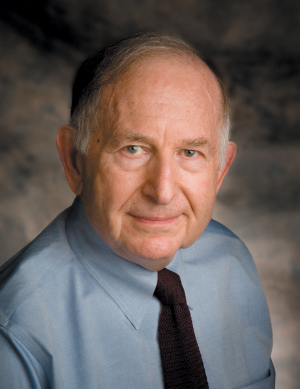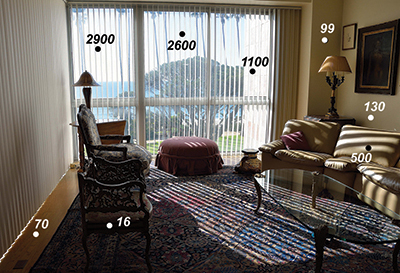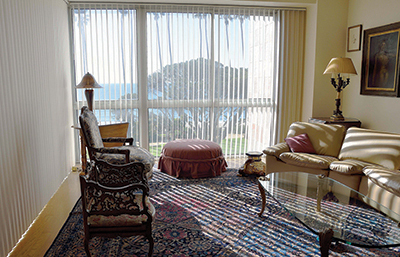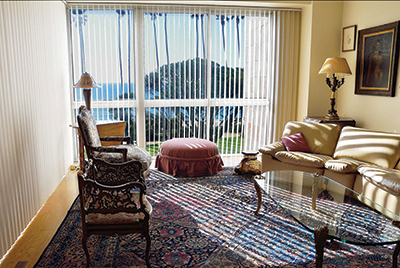14 Stops… and Counting

Bill Klages
Many video camera manufacturers, particularly those with large sensors intended for “film” acquisition, state that the dynamic range of their camera is 14 stops or 16,394:1, a very impressive ratio. The question I wish to address is this: what is the importance of this enormous range to a broadcaster?
DYNAMIC RANGE
As you are well aware, the dynamic range of a camera is the range of the subject’s brightness that the camera has the ability to detect. At the lower (black) end, the sensor detects the first glimmer of a signal above a plateau that is noise (or grain), while at the upper end (white) as the subject’s brightness increases, the output signal becomes limited, saturated and no further detail is recognizable. In the very early history of television, this range was very narrow and the brightness of the objects in the camera view had to be controlled very carefully to remain in the range of brightness that the early imaging electron tube was capable of reproducing. The sensor’s transfer curve then had to be altered so that it was the opposite of the display device’s cathode ray tube, so that the image’s values were faithfully reproduced (in black and white, of course) to the subject. Both input and output followed a power function; the display device with an exponent of 2.2, and the camera was altered to have an exponent of the inverse or 1/2.2 or 0.45. Right or wrong, these values have been with us ever since. The exponent’s value is called “gamma.”
THE TEST

Fig. 1: To illustrate dynamic range, the author chose a scene that contains a low brightness interior, as well as a high brightness exterior seen through a window. To illustrate the dynamic range, I have chosen a subject that has wide dynamic range, as it contains a low brightness interior, as well as a high brightness exterior seen through a window. So that the exposure level will be as close as possible to the middle of the range, my large sensor digital SLR camera was set to automatic exposure. The numbers added to Fig. 1 are the values in foot-lamberts (brightness) of the subjects read with my spot meter. It should be of no surprise that looking out the window, the brightness measured 2,900 foot-lamberts , while the interior’s carpet read 16 ft-L. Therefore, we can estimate that the dynamic range using these two measurement points is approximately 180:1 or a little less than 8 stops (28=216). I do not know how close my camera comes to a 14-stop range, but it is certainly greater than the eight stops.
CHANGING THE TRANSFER CHARACTERISTIC
Using Photoshop to illustrate signal alteration, we can quickly change the transfer characteristics of our image (
). Let us say that we wish to raise the low brightness of the interior relative to the average brightness of the image, but not affect the brightness of the objects viewed through the window, these objects already being quite high. This is accomplished by “stretching” the low brightness areas of the image, mostly the interior. The successful results are shown in Fig. 2. Interestingly, the amount of stretch of the black end of the scale can be duplicated in most video cameras where “gamma” is adjusted by changing its default value (usually 0.45) to a lower value.
Fig. 2: To raise the low brightness of the interior relative to the average brightness of the image, but not affect the brightness of the objects viewed through the window, the author used Photoshop to “stretch” the low brightness areas of the image, mostly the interior.Fig. 3: To adjust the transfer characteristics of the upper end of the brightness scale, the author isolated the image areas to be adjusted. ADJUSTMENT OF GAMMA
I would like to digress for a moment and make an observation that can be of great usefulness in daily studio operation. In a typical multicamera studio situation, to obtain soft nondirect fill light can be a daunting task loaded with compromise. Stretching the black end of the image by adjusting the value of gamma correction can be a very direct method to obtain a smooth increase in the filling out of shadow areas, the purpose of an even fill light. The effect is nondirective and, used with discretion, can result in a more pleasing image.


Historically, before the advent of sensors with extremely low noise level, this gamma correction adjustment was frowned upon as it would greatly decrease the signal-to-noise ratio. Today it is not an issue, as current camera sensors produce extremely low noise. Comparing Fig. 1 with Fig. 2 illustrates the application of such a correction. In Fig. 2, you can imagine that we have (electronically) added a soft overall fill light to lighten the shadow areas of our image. It is my opinion that this adjustment should be considered a simple way of raising the average brightness of a scene to make the shadow areas more transparent.
ADJUSTING THE HIGH END OF EXPOSURE SCALE
If we wish to adjust the transfer characteristics of the upper end of the brightness scale, it is a little more complicated. In our example, just applying correction to all values above mid-scale would result in changing the brightness of sections of the image that we do not wish to change. In our example, the value of the vertical blinds would be raised if we stretched the upper end of the scale, and this is certainly not desired. The solution to this dilemma should be obvious: We must isolate the image areas to be adjusted. This was actually done to create Fig. 3. Using Photoshop to place the exterior on an independent layer, we adjusted the exterior without affecting the interior image. Correction was simple: The contrast and brightness of this layer containing the exterior were adjusted independently of the interior to obtain the final image. Even though we have contained the dynamic range of the image compared to the range of the original, we have given the impression that we have increased this range (as we apparently can now see more information in the low and high ends of the image).
WHAT ABOUT THE 14 STOPS?
From my example, we are able to make some valuable conclusions. Just having the greater information due to a wider system dynamic range does not mean that we can display it. We must apply some correction to do this. In my case, I selected two different transfer functions to contain the information in the low and high ends of the range. I discovered that the low-end adjustment of the curve could be applied overall without affecting the high end of the scale, while the transfer function change in the higher brightness end had to be applied selectively. The practical application of this would necessitate a more complicated solution. In fact, it would have to be done in the post-production environment with the associated time and equipment obstacles.
REALITY CHECK
Although these tasks can be accomplished very accurately in the post-production digital signal domain, it should be (sadly) apparent that any adjustment other than applying a new overall gamma is not practical in day-to-day operation. You can still boast that your new camera has a 14- stop range but to fully utilize it might be unattainable.
Bill Klages would like to extend an invitation to all the lighting people out there to give him your thoughts atbillklages@roadrunner.com
Get the TV Tech Newsletter
The professional video industry's #1 source for news, trends and product and tech information. Sign up below.
